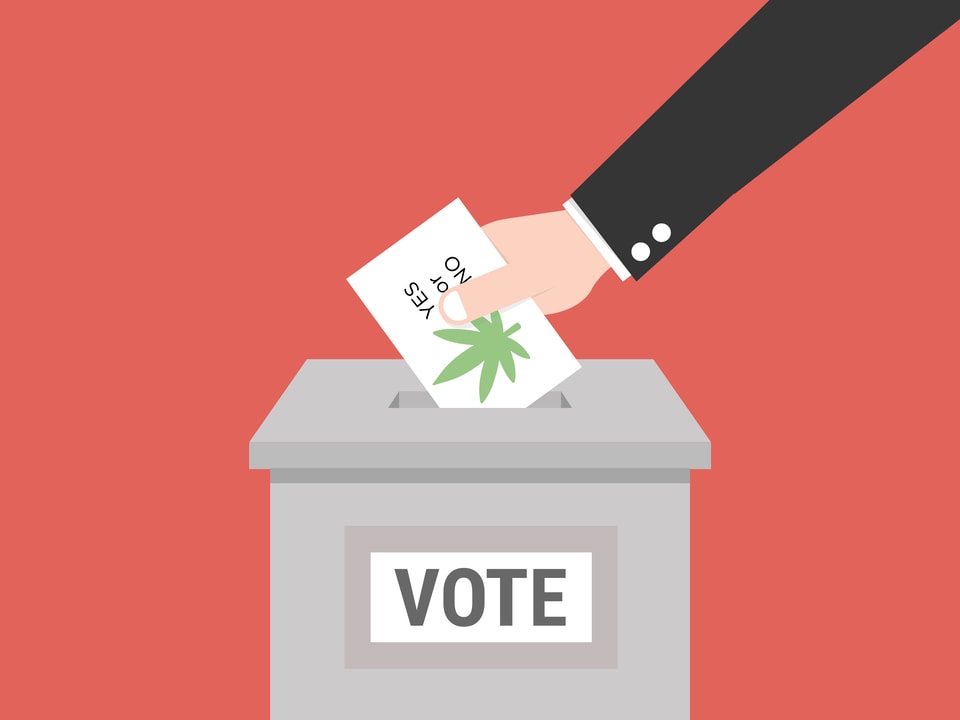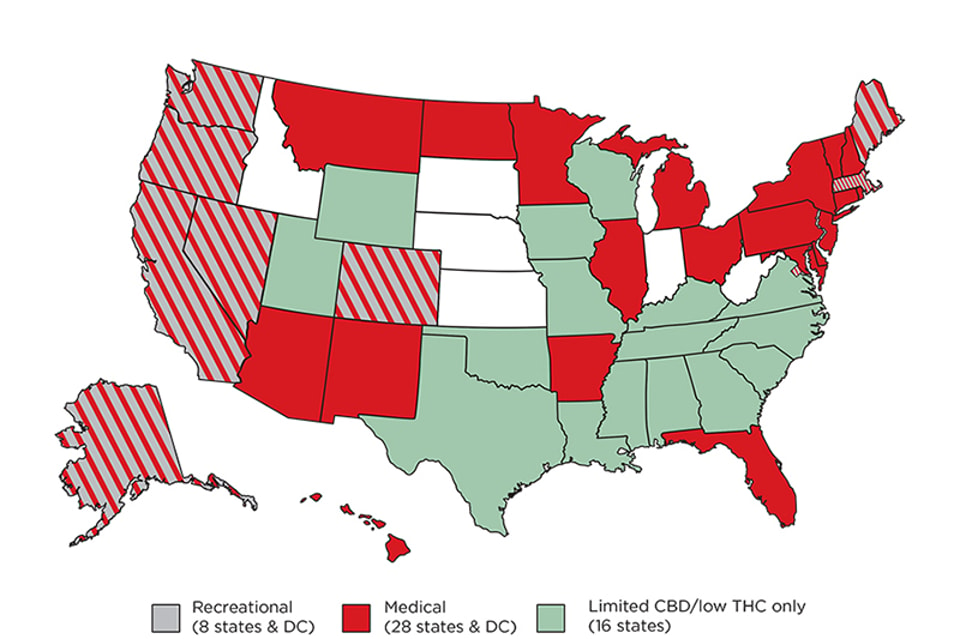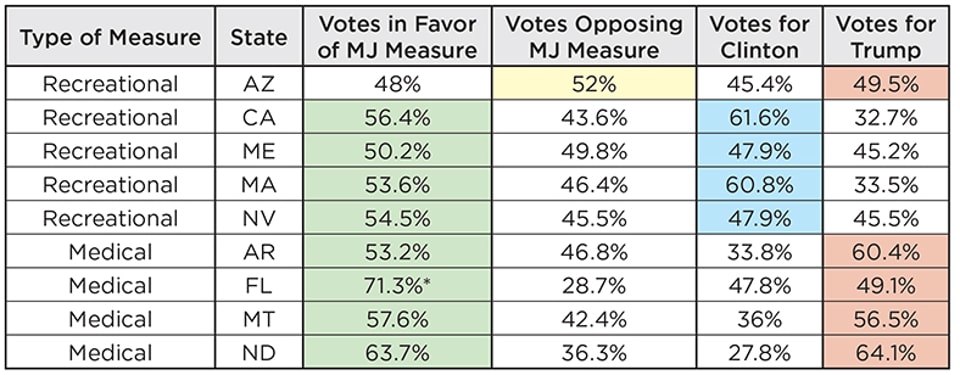Memo Published November 29, 2016 · Updated November 29, 2016 · 12 minute read
What Election Day Meant for State Marijuana Laws
Sarah Trumble

On November 8, 2016, Americans across the country voted to radically redraw the landscape of state marijuana laws. Eight of the nine state ballot measures reforming marijuana laws passed, in some states by overwhelming margins. Four states—California, Maine, Massachusetts, and Nevada—voted to legalize marijuana for recreational use by adults. Montana expanded its existing but previously limited medical marijuana law. And voters in Arkansas, Florida, and North Dakota voted to allow medical marijuana use in their states. Arizona was the only state whose marijuana-related measure failed to pass. It was a historic night for the legalization movement, as more than 77 million people live in the states that voted to reform their marijuana laws.1 This memo analyzes which states passed marijuana measures, by what margins, and with the support of which voters in order to help portend what the outcomes mean for the future of state marijuana laws.
The States
When President Obama took the Oath of Office in January 2009, only 13 states had legalized the medical use of marijuana, and none allowed its recreational use. But come President Trump’s Inauguration Day in January 2017, 28 states will have legalized medical marijauna—more than half the country—and eight will have also legalized its recreational use by adults. Those states span coast to coast, north to south, and red to blue.2

With the addition of California and Nevada to the current cohort of Colorado, Oregon, Washington, and Alaska, there is now a contiguous western bloc of states where marijuana is legal for recreational purposes. California is significant on its own—home to the largest state population in the nation, it is expected to triple the size of the existing legal marijuana market overnight.3 Maine and Massachusetts also became the first states on the East Coast to allow recreational marijuana. And with its vote, Arkansas became the first state in the Bible Belt to legalize medical marijuana. Florida is the fourth most-populous state in the nation, and it became the first state in the southeast to allow the medical use of marijuana. All four corners of the country have now legalized marijuana for either medical or recreational purposes—and three of those four corners have chosen to do the latter. Counting the 16 additional states that allow limited use of non-intoxicating cannabidoil for certain medical needs, there are now only six states in the nation without some form of marijuana legalization on the books.
The Margins
While it is true that in these nine states, more people voted in favor of marijuana than for either presidential candidate, that fact does not guarantee that reformers can necessarily expect easy victories in the future.4 This was not a clean sweep, and the voters are not as clear-cut in their views as polls make them seem. Overall, marijuana may have been victorious in both red and blue states, but it’s important to note that recreational marijuana won only in blue states, and the only attempt to pass recreational in a red state (Arizona) was the sole measure to fail. Red states did vote for reform, but only in the form of medical legalization.
November 2016 Marijuana Ballot Measures Results5

The Difference between Medical and Recreational Measures
This divide serves to highlight the difference between attitudes towards recreational and medical use of marijuana and the resulting difficulty of legalizing the former compared to the latter by popular vote. Legalizing medical use is overwhelmingly popular, with Americans reporting vastly greater margins of support than for recreational legalization (including among Republicans), as well as favorable views of medical users.6 Those attitudes, combined with the values of compassion and caring for the sick that underlie them, are why medical measures are so much easier to pass than recreational ones. This degree of ease was visible on Election Day, when the margin between the percentage of voters in favor of a marijuana measure and the percentage opposed averaged more than three times larger in states passing medical measures than in those passing recreational. On average, there was a 23-point margin of support for the medical measures that were put to voters on Election Day. And while Florida’s enormous 42.6-point margin does affect this average, three of the four medical initiatives had margins of victory wider than the winningest recreational measure. The margin of support in successful recreational initiatives averaged only seven points, and it went as low as 0.4 in Maine, where opponents are launching a recount to challenge the results.7
The Difference between Marijuana Measures and the Presidential Election
Despite marijuana measures receiving nearly 18 million yes votes in these nine states (compared to Hillary Clinton and Donald Trump’s 16 and 13 million, respectively), a state-by-state analysis shows that marijuana received more yes votes than the presidential candidate who won the state in only four of the nine states.8 The presidential election may have been very close this year (so close that the candidate who won the popular vote actually lost the election), but it was no walk in the park for the marijuana measures either. More people voted in favor of marijuana than voted for Clinton in the blue states of Nevada and Maine, but the reverse was true in California and Massachusetts, and in Maine, more people also voted against the marijuana measure than voted for Clinton. Florida and Montana were the only red states where more people voted in favor of the marijuana initiatives than for Trump—the reverse was true in Arizona, Arkansas, and North Dakota.9 More importantly, the margin of success of the marijuana measures was tighter than that of the presidential race in all but two states—the swing states of Florida and Nevada. That means in seven of the nine states that voted on marijuana this year, that vote was closer and more competitive than the race for president.10 This should serve as a warning that just because a state regularly goes blue in presidential elections doesn’t mean a marijuana vote will be an easy win. Marijuana’s margin of success in blue Maine was under half a point—less than one-fifth of the margin of the presidential race in that state.11
What these margins show is that while Election Day was indeed significant for reformers, the path to widespread legalization will not be an easy one from here. Based on the difference in support for medical compared to recreational measures and the tightness of the margins, reformers are unlikely to easily run up a string of uninterrupted victories. And unlike with an issue like marriage for gay couples, the Supreme Court won’t eventually step in to force straggling states to follow suit.
The Voters
Though Election Day was historic for marijuana reformers, both the exit polls and recent public opinion data show that this issue continues to be nuanced for voters. In Public Religion Research Institute’s (PRRI) 2016 American Values Survey, released in October, 63% of Americans favored or strongly favored making the use of marijuana legal.12 But digging into that data and comparing it to the exit polls from Election Day shows that the polling data may be overly optimistic. Though exit polls are only available on the marijuana measures in California and Arizona, there are three insights we can draw from the data that is available:
The gender gap is shrinking.

The PRRI American Values Survey confirmed a trend identified in countless other rounds of public opinion research, including Third Way’s own qualitative and quantitative studies: men are more supportive of legalization than women. But in recent years, polls show the gender gap appears to be shrinking as women’s support increases faster than men’s. In a 2010 Gallup poll, men were ten points more supportive of marijuana legalization than women, with 51% of men in favor compared to only 41% of women.13 In our 2014 poll, 52% of men were in favor of marijuana legalization compared to 45% of women, a gap of seven points.14 And in the 2016 PRRI data, both genders polled above 60% (66% of men and 61% of women favored legalization), and the gap between men and women had shrunk to only five points.15 While not conclusive, this data suggests that the gender gap may be shrinking in both size and importance.
The exit polls also bear that conclusion out. The gender gap was even smaller in California and Arizona’s marijuana measures according to the exit polls than it has been in recent public polling. In California, men outpaced women in support of the measure by only three points.16 And in Arizona, the only state whose marijuana measure failed, the gender gap actually flipped—with women out-supporting men by two points.17 Yet neither state saw the significant upward shift in support the most recent polls have indicated. In Arizona, neither male nor female voters reached 50% support—only 49% of women and 47% of men voted for legalization.18 And even in California, a blue state where the marijuana measure passed by nearly 13 points, neither men nor women approached support numbers in the 60s as predicted by the polling. California men and women both voted in favor of legalization but at 58% and 55%, respectively.19 So while it’s true that the gender gap looks to be shrinking, public polls also appear to be overstating actual support at the ballot box among both men and women.
Age differences are significant——but they may be more nuanced than we think.
When it comes to support for marijuana legalization, age differences are much more pronounced than those by gender. According to the PRRI survey, 74% of Americans ages 18-29 favored recreational legalization, 31 points higher than the 43% of voters ages 65 or older who did so. Though support decreased with age in that poll, every age group under 65 polled above 60% support for legalization. Conversely, voters over 65 voiced stronger opposition (56%) than Republicans (46% support vs. 53% oppose) or conservatives (45% support vs. 53% oppose).20
Age at Which Voters Flipped from Majority Support to Majority Opposition

Exit polls in Arizona and California confirmed this age difference—but both found the split between support and opposition occurring significantly earlier than age 65. In Arizona a majority of every age group over 40 years old voted against the marijuana measure, with the strongest opposition occurring among the oldest voters.21 And even in California, where the recreational initiative passed by a significant margin, the vote flipped to majority opposition at 50 years old.22 In neither state did 18-29 year olds actually vote at the 74% support seen in the PRRI poll (though California was quite close at 72% support among that age range, Arizona had only 64%).23 These exit poll numbers may indicate that the age difference is more subtle and less stark than it looks in polls.
Further illustrating the nuanced correlation of attitudes and age is the result in Florida, where the medical marijuana measure won decisively. Despite the fact that it is the oldest state in the nation (with 19% of its population over 65 years old), Florida’s measure not only received the highest percentage of voter support (71.3%), but also the widest margin of support (42.6 points)24 There are no exit polls available to show how the age divide played out among Florida marijuana voters, but this suggests that perhaps the age breaks are less prevalent, or even nonexistent, when it comes to medical marijuana.
The partisan breakdown at the ballot may be wider than polls suggest.

In the PRRI survey, Democrats and Independents had similar views of legalization: support among both was at 69%, with 34% of Democrats and 37% of Independents strongly supporting it. Only 31% of Democrats and 30% of Independents opposed legalization in that poll—more than 20 points fewer than the 53% of Republicans who were opposed. Only 46% of the Republicans polled supported legalization, with a mere 18% doing so strongly.25
But it turns out the 23-point spread between the parties in polls may be even wider at the ballot box. Exit polls showed Republicans were less supportive than polls have indicated, and Independents failed to match the Democrats’ level of support for legalization. Democrats were the most supportive in both states where data by party is available, with 67% voting in favor of California’s proposition and a whopping 77% voting in favor of Arizona’s—eight points higher than in the PRRI poll. But the partisan gap expanded even more in the other direction—while PRRI’s poll showed 46% of Republicans in support of legalization, only 15% of Arizona Republicans and 31% of California Republicans voted in favor of the marijuana measure on their ballot. And even though Independents did support the legalization measure in both states (53% to 47% in Arizona and 59% to 41% in California), they were 24 and 8 points behind Democrats in those states respectively.26
This widening party gap did not necessarily translate into marijuana measures tracking with the top of the ticket in this presidential election. While California and Massachusetts both voted for the Democratic presidential nominee with over 60% support, neither state reached that level of support for their marijuana measure. The opposite occurred in Florida and Montana, where Donald Trump won, but not by as large a percentage as marijuana did.27
Conclusion
Election Day 2016 was historic for marijuana reform at the state level. Voters doubled the number of states where the recreational use of marijuana is legal, expanded the scope of Montana’s previously-existing medical marijuana law, and added three new states to the 25 where medical use was already legal—finally pushing the nation over the half-way mark on medical marijuana. But that doesn’t mean that reformers will have an easy path forward from here. Support for marijuana is not as clear-cut as national polls may appear, and Americans still seem to see the issue as nuanced. The future of marijuana reform at the state level will depend on how well these newly-passed initiatives are implemented, and how these and future states work to address voters’ remaining concerns about legalization.
